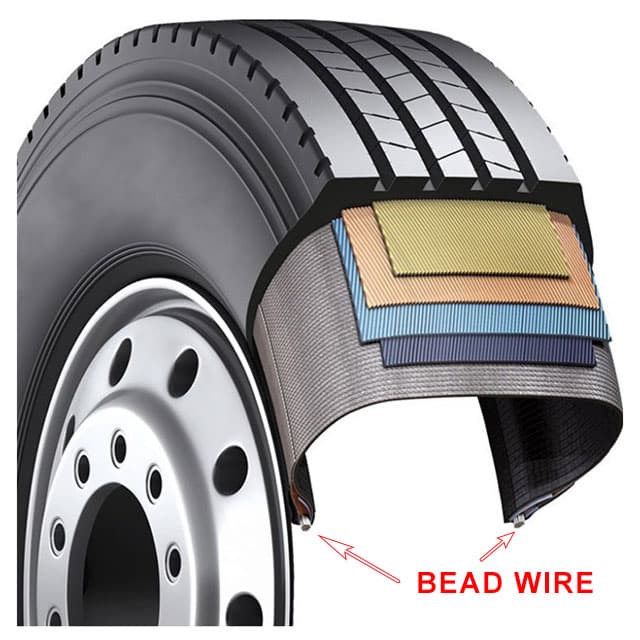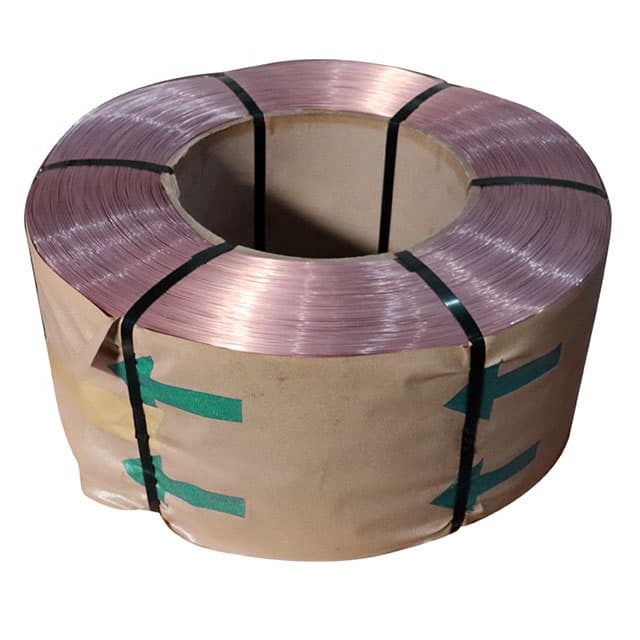TIRE BEAD WIRE MANUFACTURING
TIRE BEAD WIRE MANUFACTURING EQUIPMENT
Bead wire application
Bead wire is widely used in rubber industry:
- for the production of bead rings of tires;
- reinforcement of passenger cars, trucks and light truck tires to give necessary rigidity to tire beads;
- reinforcing steel cord conveyor belts and high-pressure hoses.
Bead wire is widely used for reinforcement of cars, trucks, light truck tires, to give the necessary rigidity to tire beads.
The main reinforcing element of the bead part of tires is a bead ring made of steel wire coated with bronze to provide chemical bond with rubber. Bead wire contains of fiber stands disposed so as to provide both high strength and certain degree of flexibility needed for mounting and dismounting tires. Carcass layers are wrapped around the bead wire fixing carcass layers and holds the assembly on the wheel rim, thereby preventing the tire from rolling or sliding, providing road performance of the tire.
Bead wire for bias and bias-belted tires is used on both sides of the tire. In cast tires bead wire is used for fixing the tire to the rim.


Technological process of bead wire manufacturing
Ø1.55 mm~Ø1.65 mm
Ø5.5~Ø6.5 mm Mechanical descaling, electrolytic etching,
boraxing, drawing up to Ø1.55~Ø1.65 mm Heat treatment, rinsing,
wire bronzing line Checking, packaging
and storage
Ø0.78 mm~Ø0.96 mm
Ø0.78~Ø0.96 mm Mechanical descaling, electrolytic
etching, boraxing, drawing up to Ø2.80 mm Heat treatment, rinsing,
wire bronzing line Drawing up to
Ø0.78~Ø0.96 mm Heat treatment, rinsing,
wire bronzing line Checking, packaging
and storage
PRODUCTION EQUIPMENT AND PRODUCT SPECIFICATION
| Productivity | 8000 tons/ year |
|---|---|
| Bead Wire Range | Ø1.55 mm~Ø1.65 mm and Ø0.78 mm~Ø0.96 mm |
| Power Consumption | 800 kW/h |
| Water consumption | 6 m3/h |
| Steam consumption | 2000 kg/h |
| Waste water type | FeSO4 waste water; CuSO4 waste water |
| exhaust gas | vapor H2SO4 |
As steel cord as bead wire are coated with an alloy that increases the strength of the connection with the tires. Special brass coatings are used almost exclusively to the steel cord and only in some cases.
Bronze coating is most common for the bead wire. Chemical formation of adhesion to brass-coated steel cord is very complex. Brass layer made of zinc and copper, and the composition gradient of the steel cord to the rubber surface are very important for this process.
Theoretically, depending on starting reactivity of the mixture brass alloy forms intermediate layers of zinc, sulphide and copper. The rates of these layers formation are determined by the initial level and durability of the connection.
Equipment for the production of bead wire
| Machine name and type | Qty | |
|---|---|---|
| 1. | Mechanical descaling, electrolytic etching, wire boraxing line | 2 |
| 2. | RG155-165 straight through wire drawing machine | 1 |
| 3. | RG078-096 straight through wire drawing machine | 2 |
| 4. | Heat treatment + acid etching, wire phosphatizing line | 1 |
| 5. | Heat treatment + acid etching, wire bronzing line | 1 |
Required personnel (for output of 16000 tons/year)
| Technological process | Working Shift | Operating Personnel | Total | |
|---|---|---|---|---|
| 1. | Wire Drawing | 4 | 4 | 16 |
| 2. | Hardening + acid etching | 4 | 4 | 16 |
| 3. | Heat treatment + chemical coating line | 4 | 5 | 20 |
| 4. | Manager | 1 | 6 | 6 |
| 5. | Total | 58 | ||
Environmental Protection
When this device operated three types of polluting waste are formed: acid vapors; waste water with acid-content; waste water coming from the brass plating line.
To eliminate acid vapors indoor air pollution control system is used.
For treatment of waste water with acid-content and waste water from the brass plating line: uniformity, neutralization, aeration, sedimentation and filtration are applied. Water can be discharged after reaching standards.
| Operational process | Wastewater type | Material type | Concentration, mg/l | Output, l/h | Unloading Amount, m3 |
|---|---|---|---|---|---|
| Mechanical descaling | Acid waste | Fe | 350 | 2000 | 48 |
| SO4 | 2800 | ||||
| Heat treatment | Acid waste | Fe | 350 | 3600 | 86.4 |
| SO4 | 2800 | ||||
| Wire Brozing Line | Copper coating wastewater | Cu | 20 | 1500 | 36 |
| Fe | 20 | ||||
| SO4 | 50 | ||||
| Acid waste | Fe | 200 | 1000 | 24 | |
| SO4 | 1500 |
| Operational process | Dissolution type | Material type | Concentration, mg/l | Amount |
|---|---|---|---|---|
| Mechanical descaling | Acid Solution | H2SO4 | 250 | Change every 2 months, total volume 8 m3 |
| FeSO4 | 100 | |||
| Heat treatment | Acid Solution | H2SO4 | 250 | Change 1 time per month, total volume 10 m3 |
| FeSO4 | 120 | |||
| Borax Liquor | Na2B4O7 × 10H2O | 170 | Change 1 time per month, total volume 86 m3 | |
| Wire Brozing Line | Acid Solution | H2SO4 | 250 | Change 1 time per 2 month, total volume 5 m3 |
| FeSO4 | 100 | |||
| Cooper sulphate solution | CuSO4 × 5H2O | 15 | Change 1 time per month, total volume 10 m3 |
| Operational process | Vapor output, m3 | Number of equipment lines | Total vapor volume, m3 |
|---|---|---|---|
| Wire Rod Preparation | 2000 | 2 | 4000 |
| Wire Patenting | 6000 | 2 | 12000 |
| Electrolytic Etching on Wire Bronzing Line | 3000 | 1 | 3000 |
The total vapor concentration is 18 mg/m3. After heat treatment and unloading, the concentration is 0.99 m3, which meets environmental standards.